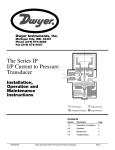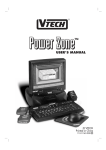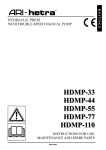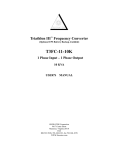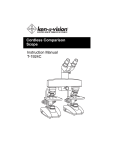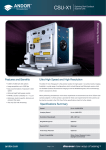Download Magnifications Specifications Model MFL-02
Transcript
the eyepiece and SLOWLY turn the focusing knob until the image of the specimen becomes clear. Be careful not to let the slide touch the lens. You will also see a black line pointing to the center of your specimen. This is the pointer installed inside the eyepiece. By turning the eyepiece, you can move the position of the pointer. Use this to point out specific parts of your specimen (move the slide if necessary). Microscopes such as My First LabTM are used in schools worldwide to observe various biological specimens. 15W electric illumination (lighting) offers a clear view of your specimens and the 10X magnifying power of the eyepiece combined with 4X, 10X or 40X power objective lens provides a magnified view of 40X, 100X or 400X of the specimen being observed. The disc diaphragm, located directly below the stage, has six different size apertures (openings) which allow light to pass through to shine on the specimen. By rotating this disc, you can alter the amount of light that is aimed at the specimen. Try experimenting with various settings to get the most effective view of your specimen. After focusing you can move the slide left or right on the stage to observe different sections of the same specimen. As you adjust the slide or the aperture disc, be careful not to put weight against the stage as this could push it out of focus. After observing with the 4X objective (which shows you the image magnified 40X), rotate the nosepiece to the 10X objective lens (leave the slide in place on the stage). Again SLOWLY turn the focusing knob to get a clear view of your specimen at 100X magnification. Always use caution since the focusing knob actually moves the stage closer to the objective lens. Increase your magnification to 400X by using the 40X objective lens. The higher the magnification, the closer the objective must be to the specimen being observed. The 40X lens is “spring loaded” meaning the tip of it will bounce back slightly when touched. However, always focus SLOWLY and be aware of how close the slide is to the objective lens at all times. 4 Magnifications 10X Eyepiece + 4X Objective = 40X magnification 10X Eyepiece + 10X Objective = 100X magnification 10X Eyepiece + 40X Objective = 400X magnification Specifications Model MFL-02 Eyepiece: 10X Widefield with pointer Monocular head: 360° rotatable Objective lenses: 4X, 10X & 40X (spring loaded) Magnifications: 40X, 100X & 400X Disc Diaphragm: six apertures Illumination: 15W 110V* Dimensions: 4¼" x 8½" x 11" high Net Weight: 3½ lbs. *Instrument may be manufactured with 220V where appropriate. Save the plastic bag that the microscope comes packed in to use as a dust cover when your microscope is not in use. 1 Components of Microscope Operation Study the picture below to become familiar with the different parts of your microscope. Please read this section completely before using your microscope. 10X Eyepiece with pointer Screw Carefully plug the power cord into a nearby electric outlet. Be sure the cord does not hang where it can be tripped over or pulled during operation of the microscope. Head Locking nut Nosepiece Objective lenses Focusing knob Stage Set up your microscope instrument on a sturdy smooth surface such as a desk or tabletop. Air should be able to flow under the bottom of the microscope to allow proper ventilation for the lamp. Never operate the microscope on a bed or other soft cushioned surface since this could lead to overheating and cause a fire hazard. Clips Position the microscope for comfortable viewing. Note that the head or eyepiece tube is rotatable. By using a tiny straight screwdriver (not included) such as those used for eyeglasses, you can loosen the three screws slightly to rotate the head to any position. Carefully tighten the screws when you have the head in the desired position. Includes five Prepared Slides (microscope slides containing a specimen, usually “prepared” by staining tube the tissueEyepiece for observation under the microscope.) Check the objective lenses and if necessary rotate the nosepiece so that the 4X objective lens is in position for viewing. Always begin observation of any specimen with the 4X objective and increase power as needed. Select a prepared slide (included) to observe and place it carefully on the stage. Push gently on the back of the clips to lift the arm enough to slip the slide under and hold it in place. The main part of the specimen should be centered over the opening in the stage. Practice a minute by watching the slide on the stage (not looking through the eyepiece) while turning the focusing knob and notice which direction you turn the knob to move the stage closer to the objective lens. Now turn on the power switch to illuminate (light) the specimen. Then, look through 2 3 Illuminator Disc diaphragm Always turn off the power immediately when not in use to avoid overheating of the microscope lamp. Allow the microscope to cool completely before storing or covering it with the plastic storage cover. With a little practice, you can soon become expert at observing all types of specimens with My First LabTM Microscope. Focusing Tips: When focusing your microscope, turn the knob only until the stage stops moving. DO NOT FORCE IT. This microscope is equipped with a “locking nut” to help prevent the stage from moving up far enough to collide with the objectives. This locking nut is pre-set in position at the factory and should not require adjustment. If you find that the stage is not moving up far enough to get your specimen in focus, try turning the locking knob slightly to allow the stage to travel farther. Remember to always focus SLOWLY and be aware of how close the slide is to the objective lens at all times. Maintenance Store your microscope in a cool dry place. Always cover with the plastic storage bag provided or return to the box when not in use. This microscope is not designed to be immersed in water. Changing the light bulb Adult supervision recommended. Unplug the microscope from power source. Turn the instrument over and using a small Phillips head screwdriver, remove the four screws from each corner of the bottom plate. Remove the old bulb by pushing in slightly and turning to release the bulb from its socket. Insert a new 15W bulb pushing in and turning to lock in place. (Wipe fingerprints from bulb or wear gloves). Replace bottom plate. The maximum safe wattage for replacement bulbs is 15 watts. 5 Limited One Year Warranty The manufacturer warrants this instrument to be free from defects in material and workmanship under normal use for one year from the date of purchase. It does not cover damage resulting from abuse or misuse, repairs or alterations performed by other than authorized repair technicians, or damage occurring in transit. If you have questions concerning this product or warranty, contact the dealer from whom it was purchased. For warranty service, microscope should be well packed to avoid damage in transit, preferably in original box and packing. Include your complete return address and telephone number as well as a description of the difficulty, date and place of purchase, and ship to the address below. It will be repaired or replaced at no charge and returned. If misuse, alterations, accident or abnormal conditions of operation caused failure, an estimate for repairs will be provided for your approval prior to work being performed. My First Lab™ Microscope If you have questions concerning this product or warranty, contact the dealer from whom it was purchased or. Microscope Service Department 7241 Gabe Court Manassas, VA 20109-2434 USER'S MANUAL (9/4) Made in China This microscope is intended for use by ages 11 & older. Parents are reminded this is an electrical instrument and contains glass microscope slides. Proper handling is essential. Always follow the appropriate safety procedures.





